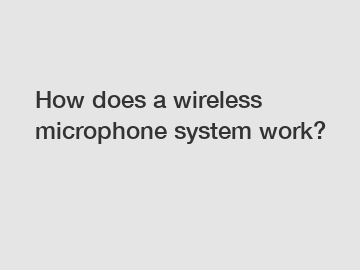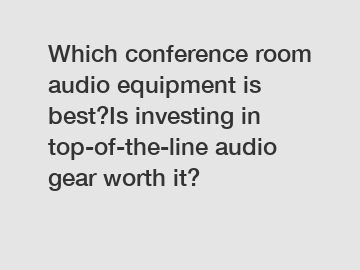How does a wireless microphone system work?
In the vibrant world of sound technology, wireless microphone systems constitute a crucial tool that empowers performers, presenters, and speakers to cut the cord and roam freely on the stage or podium. These incredible devices have revolutionized the way we capture and amplify sound. But have you ever wondered how they actually work? In this blog, we'll delve into the intricacies of wireless microphone systems, showcasing the magic and science behind their operation.
1. The Basics: Transmitter and Receiver:
At the heart of any wireless microphone system lies a transmitter and a receiver. The transmitter, typically held by the performer or speaker, converts sound waves into radio frequency (RF) signals. These signals are then wirelessly transmitted to the receiver, which is connected to a sound system or a mixing console. The receiver's primary task is to convert the RF signals back into audible sound and ensure its seamless amplification.

2. Frequencies and Channels:
To prevent interference and maintain clear audio transmission, wireless microphone systems operate on specific frequencies and utilize different channels. Frequencies can range from several megahertz up to several gigahertz, depending on the system and its intended use. Channels, on the other hand, allow multiple wireless microphones to coexist in the same environment by dividing the available frequency spectrum.
3. Diversity Reception:
Wireless microphone systems often employ a technique called diversity reception to optimize signal quality and minimize dropouts caused by interference. This technique utilizes multiple antennas, usually spaced apart, to capture the transmitted signal from various angles. By constantly monitoring the signal strength and quality, the receiver can automatically switch to the antenna with the strongest and clearest signal, thereby ensuring uninterrupted audio transmission.
4. Analog vs. Digital Wireless Systems:
Additional resources:What is a conference microphone system?
Conference Room Audio Video Solutions
What is video wall processor?
Revolutionize Conferences: All-In-One Paperless Control System for Multimedia Events
What are the top audio conference equipment in 2022?
Top 5 Tips for Choosing High Definition PTZ Cameras: Which Features Should You Prioritize?
What is a Video Distribution System?
Traditionally, wireless microphone systems operated in the analog domain. However, the advent of digital technology has revolutionized the audio industry, leading to the rise of digital wireless microphone systems. While analog systems directly transmit the audio waveform as electrical signals, digital systems convert the audio into a stream of digital data. This transition allows for improved sound quality, enhanced clarity, and increased resistance to interference.
5. Encryption and Security:
With wireless transmissions susceptible to eavesdropping and unauthorized access, modern wireless microphone systems reinforce their security through advanced encryption techniques. Encrypted digital transmission ensures that only compatible receivers equipped with the appropriate encryption keys can decipher and reproduce the transmitted audio. This adds an extra layer of protection, giving performers peace of mind when using wireless microphone systems.
6. Battery Life and Power Management:
Wireless microphone systems heavily rely on battery power to function smoothly. Both transmitters and receivers require energy to operate, making battery life a critical factor to consider. To maximize battery longevity, modern systems often implement power management techniques, such as sleep modes, low-power consumption components, and efficient signal processing algorithms. Additionally, built-in battery status indicators on transmitters and receivers help performers monitor power levels and ensure a hassle-free performance.
Conclusion:
Wireless microphone systems have become an indispensable tool in the dynamic world of performance and public speaking. By harnessing the power of wireless technology, these systems allow performers to unleash their creativity and connect with audiences on an even deeper level. Understanding the inner workings of these devices not only demystifies their magic but also instills confidence in their reliability and performance. So, the next time you witness a passionately delivered presentation or an electrifying stage performance, you'll have a newfound appreciation for the incredible wireless microphone system aiding in the magic.
The company is the world’s best video wall matrix, 5g access point, conference sound system supplier. We are your one-stop shop for all needs. Our staff are highly-specialized and will help you find the product you need.
Additional resources:Revolutionizing Conference Networking: Unraveling the Power of Professional Conference Systems
Revolutionize Conference Rooms with Wireless Mic System: Say Goodbye to Annoying Microphone Cables!
How do we set up audio and video conference?
Revolutionizing Congress: Say Goodbye to Paper! Unveiling the Ultimate Paperless Multimedia Terminal
Is there a time limit on FreeConferenceCall?
Cut Costs & Stream Seamlessly: Discover The Future of Conferences with Paperless Streaming Server
Which Modular Seamless Video Wall Processor 68X68 Comes With the Best Features?
97
0
0
Related Articles
-
Which Innovative Techniques will Revolutionize Interpreter Booths?
Which Innovative Techniques will Revolutionize Interpreter Booths?
51
0
0
-
Unlocking Success: Mastering the Video Matrix System
Google Hot Topics: Unlocking Success: Mastering the Video Matrix System.
57
0
0
-
49
0
0
-
Ultimate Guide to Height-Adjustable Touch Screen with Array MIC
**Ultimate Guide to Height-Adjustable Touch Screen with Array MIC**.
53
0
0
-
Which is the best paperless conference system for final purchase?
Which is the best paperless conference system for final purchase?
42
0
0
-
36
0
0
-
34
0
0
-
How high should a conference room monitor be mounted?
When setting up a conference room, one crucial decision to make is how high to mount the monitor.
40
0
0









Comments
All Comments (0)